Difference between revisions of "Hypostatic abstraction"
Jon Awbrey (talk | contribs) (cats) |
Jon Awbrey (talk | contribs) |
||
| (11 intermediate revisions by the same user not shown) | |||
| Line 1: | Line 1: | ||
| − | + | <font size="3">☞</font> This page belongs to resource collections on [[Logic Live|Logic]] and [[Inquiry Live|Inquiry]]. | |
| − | + | '''Hypostatic abstraction''' is a formal operation that takes an element of information, as expressed in a proposition <math>X ~\text{is}~ Y,\!</math> and conceives its information to consist in the relation between that subject and another subject, as expressed in the proposition <math>X ~\text{has}~ Y\!\text{-ness}.\!</math> The existence of the abstract subject <math>Y\!\text{-ness}\!</math> consists solely in the truth of those propositions that contain the concrete predicate <math>Y.\!</math> Hypostatic abstraction is known by many names, for example, ''hypostasis'', ''objectification'', ''reification'', and ''subjectal abstraction''. The object of discussion or thought thus introduced is termed a ''[[hypostatic object]]''. | |
| − | The | + | The above definition is adapted from the one given by introduced [[Charles Sanders Peirce]] (CP 4.235, “[[The Simplest Mathematics]]” (1902), in ''Collected Papers'', CP 4.227–323). |
| − | For example, a typical case of hypostatic abstraction occurs in the transformation from | + | The way that Peirce describes it, the main thing about the formal operation of hypostatic abstraction, insofar as it can be observed to operate on formal linguistic expressions, is that it converts an adjective or some part of a predicate into an extra subject, upping the ''arity'', also called the ''adicity'', of the main predicate in the process. |
| + | |||
| + | For example, a typical case of hypostatic abstraction occurs in the transformation from “honey is sweet” to “honey possesses sweetness”, which transformation can be viewed in the following variety of ways: | ||
<br> | <br> | ||
| Line 13: | Line 15: | ||
<p>[[Image:Hypostatic Abstraction Figure 4.png|center]]</p><br> | <p>[[Image:Hypostatic Abstraction Figure 4.png|center]]</p><br> | ||
| − | The grammatical trace of this hypostatic transformation tells of a process that abstracts the adjective | + | The grammatical trace of this hypostatic transformation tells of a process that abstracts the adjective “sweet” from the main predicate “is sweet”, thus arriving at a new, increased-arity predicate “possesses”, and as a by-product of the reaction, as it were, precipitating out the substantive “sweetness” as a new second subject of the new predicate, “possesses”. |
| + | |||
| + | ==See also== | ||
| + | |||
| + | * [[Hypostatic object]] | ||
| + | * [[Prescisive abstraction]] | ||
==References== | ==References== | ||
| − | * [[Charles Sanders Peirce|Peirce, C.S.]], ''Collected Papers of Charles Sanders Peirce'', vols. | + | * [[Charles Sanders Peirce|Peirce, C.S.]], ''Collected Papers of Charles Sanders Peirce'', vols. 1–6, Charles Hartshorne and Paul Weiss (eds.), vols. 7–8, Arthur W. Burks (ed.), Harvard University Press, Cambridge, MA, 1931–1935, 1958. |
==Resources== | ==Resources== | ||
| Line 29: | Line 36: | ||
===Focal nodes=== | ===Focal nodes=== | ||
| − | |||
| − | |||
* [[Inquiry Live]] | * [[Inquiry Live]] | ||
| − | |||
* [[Logic Live]] | * [[Logic Live]] | ||
| − | |||
===Peer nodes=== | ===Peer nodes=== | ||
| − | * [http:// | + | * [http://intersci.ss.uci.edu/wiki/index.php/Hypostatic_abstraction Hypostatic Abstraction @ InterSciWiki] |
* [http://mywikibiz.com/Hypostatic_abstraction Hypostatic Abstraction @ MyWikiBiz] | * [http://mywikibiz.com/Hypostatic_abstraction Hypostatic Abstraction @ MyWikiBiz] | ||
| − | * [http:// | + | * [http://ref.subwiki.org/wiki/Hypostatic_abstraction Hypostatic Abstraction @ Subject Wikis] |
| + | * [http://en.wikiversity.org/wiki/Hypostatic_abstraction Hypostatic Abstraction @ Wikiversity] | ||
| + | * [http://beta.wikiversity.org/wiki/Hypostatic_abstraction Hypostatic Abstraction @ Wikiversity Beta] | ||
===Logical operators=== | ===Logical operators=== | ||
| Line 100: | Line 105: | ||
{{col-end}} | {{col-end}} | ||
| − | === | + | ===Information, Inquiry=== |
| − | * [ | + | {{col-begin}} |
| + | {{col-break}} | ||
| + | * [[Inquiry]] | ||
| + | * [[Dynamics of inquiry]] | ||
| + | {{col-break}} | ||
| + | * [[Semeiotic]] | ||
| + | * [[Logic of information]] | ||
| + | {{col-break}} | ||
| + | * [[Descriptive science]] | ||
| + | * [[Normative science]] | ||
| + | {{col-break}} | ||
| + | * [[Pragmatic maxim]] | ||
| + | * [[Truth theory]] | ||
| + | {{col-end}} | ||
| − | + | ===Related articles=== | |
| − | * [http:// | + | {{col-begin}} |
| + | {{col-break}} | ||
| + | * [http://intersci.ss.uci.edu/wiki/index.php/Cactus_Language Cactus Language] | ||
| + | * [http://intersci.ss.uci.edu/wiki/index.php/Futures_Of_Logical_Graphs Futures Of Logical Graphs] | ||
| + | * [http://intersci.ss.uci.edu/wiki/index.php/Propositional_Equation_Reasoning_Systems Propositional Equation Reasoning Systems] | ||
| + | {{col-break}} | ||
| + | * [http://intersci.ss.uci.edu/wiki/index.php/Differential_Logic_:_Introduction Differential Logic : Introduction] | ||
| + | * [http://intersci.ss.uci.edu/wiki/index.php/Differential_Propositional_Calculus Differential Propositional Calculus] | ||
| + | * [http://intersci.ss.uci.edu/wiki/index.php/Differential_Logic_and_Dynamic_Systems_2.0 Differential Logic and Dynamic Systems] | ||
| + | {{col-break}} | ||
| + | * [http://intersci.ss.uci.edu/wiki/index.php/Introduction_to_Inquiry_Driven_Systems Introduction to Inquiry Driven Systems] | ||
| + | * [http://intersci.ss.uci.edu/wiki/index.php/Prospects_for_Inquiry_Driven_Systems Prospects for Inquiry Driven Systems] | ||
| + | * [http://intersci.ss.uci.edu/wiki/index.php/Inquiry_Driven_Systems Inquiry Driven Systems : Inquiry Into Inquiry] | ||
| + | {{col-end}} | ||
==Document history== | ==Document history== | ||
| Line 112: | Line 143: | ||
Portions of the above article were adapted from the following sources under the [[GNU Free Documentation License]], under other applicable licenses, or by permission of the copyright holders. | Portions of the above article were adapted from the following sources under the [[GNU Free Documentation License]], under other applicable licenses, or by permission of the copyright holders. | ||
| − | + | * [http://intersci.ss.uci.edu/wiki/index.php/Hypostatic_abstraction Hypostatic Abstraction], [http://intersci.ss.uci.edu/ InterSciWiki] | |
| − | |||
* [http://mywikibiz.com/Hypostatic_abstraction Hypostatic Abstraction], [http://mywikibiz.com/ MyWikiBiz] | * [http://mywikibiz.com/Hypostatic_abstraction Hypostatic Abstraction], [http://mywikibiz.com/ MyWikiBiz] | ||
| − | + | * [http://planetmath.org/HypostaticAbstraction Hypostatic Abstraction], [http://planetmath.org/ PlanetMath] | |
| − | |||
| − | * [http://planetmath.org | ||
| − | |||
| − | |||
* [http://vectors.usc.edu/thoughtmesh/publish/146.php Hypostatic Abstraction], [http://vectors.usc.edu/thoughtmesh/ ThoughtMesh] | * [http://vectors.usc.edu/thoughtmesh/publish/146.php Hypostatic Abstraction], [http://vectors.usc.edu/thoughtmesh/ ThoughtMesh] | ||
| − | * [http:// | + | * [http://wikinfo.org/w/index.php?title=Hypostatic_abstraction Hypostatic Abstraction], [http://wikinfo.org/w/ Wikinfo] |
| − | * [http:// | + | * [http://en.wikiversity.org/wiki/Hypostatic_abstraction Hypostatic Abstraction], [http://en.wikiversity.org/ Wikiversity] |
| − | * [http:// | + | * [http://beta.wikiversity.org/wiki/Hypostatic_abstraction Hypostatic Abstraction], [http://beta.wikiversity.org/ Wikiversity Beta] |
* [http://en.wikipedia.org/w/index.php?title=Hypostatic_abstraction&oldid=69736615 Hypostatic Abstraction], [http://en.wikipedia.org/ Wikipedia] | * [http://en.wikipedia.org/w/index.php?title=Hypostatic_abstraction&oldid=69736615 Hypostatic Abstraction], [http://en.wikipedia.org/ Wikipedia] | ||
| − | |||
| − | |||
| − | |||
| + | [[Category:Charles Sanders Peirce]] | ||
[[Category:Inquiry]] | [[Category:Inquiry]] | ||
| − | |||
| − | |||
| − | |||
[[Category:Logic]] | [[Category:Logic]] | ||
[[Category:Mathematics]] | [[Category:Mathematics]] | ||
| + | [[Category:Ontology]] | ||
[[Category:Philosophy]] | [[Category:Philosophy]] | ||
| + | [[Category:Pragmatism]] | ||
[[Category:Semiotics]] | [[Category:Semiotics]] | ||
Latest revision as of 18:58, 10 November 2015
☞ This page belongs to resource collections on Logic and Inquiry.
Hypostatic abstraction is a formal operation that takes an element of information, as expressed in a proposition \(X ~\text{is}~ Y,\!\) and conceives its information to consist in the relation between that subject and another subject, as expressed in the proposition \(X ~\text{has}~ Y\!\text{-ness}.\!\) The existence of the abstract subject \(Y\!\text{-ness}\!\) consists solely in the truth of those propositions that contain the concrete predicate \(Y.\!\) Hypostatic abstraction is known by many names, for example, hypostasis, objectification, reification, and subjectal abstraction. The object of discussion or thought thus introduced is termed a hypostatic object.
The above definition is adapted from the one given by introduced Charles Sanders Peirce (CP 4.235, “The Simplest Mathematics” (1902), in Collected Papers, CP 4.227–323).
The way that Peirce describes it, the main thing about the formal operation of hypostatic abstraction, insofar as it can be observed to operate on formal linguistic expressions, is that it converts an adjective or some part of a predicate into an extra subject, upping the arity, also called the adicity, of the main predicate in the process.
For example, a typical case of hypostatic abstraction occurs in the transformation from “honey is sweet” to “honey possesses sweetness”, which transformation can be viewed in the following variety of ways:
The grammatical trace of this hypostatic transformation tells of a process that abstracts the adjective “sweet” from the main predicate “is sweet”, thus arriving at a new, increased-arity predicate “possesses”, and as a by-product of the reaction, as it were, precipitating out the substantive “sweetness” as a new second subject of the new predicate, “possesses”.
See also
References
- Peirce, C.S., Collected Papers of Charles Sanders Peirce, vols. 1–6, Charles Hartshorne and Paul Weiss (eds.), vols. 7–8, Arthur W. Burks (ed.), Harvard University Press, Cambridge, MA, 1931–1935, 1958.
Resources
Syllabus
Focal nodes
Peer nodes
- Hypostatic Abstraction @ InterSciWiki
- Hypostatic Abstraction @ MyWikiBiz
- Hypostatic Abstraction @ Subject Wikis
- Hypostatic Abstraction @ Wikiversity
- Hypostatic Abstraction @ Wikiversity Beta
Logical operators
Template:Col-breakTemplate:Col-breakTemplate:Col-endRelated topics
- Propositional calculus
- Sole sufficient operator
- Truth table
- Universe of discourse
- Zeroth order logic
Relational concepts
Information, Inquiry
Related articles
- Differential Logic : Introduction
- Differential Propositional Calculus
- Differential Logic and Dynamic Systems
- Introduction to Inquiry Driven Systems
- Prospects for Inquiry Driven Systems
- Inquiry Driven Systems : Inquiry Into Inquiry
Document history
Portions of the above article were adapted from the following sources under the GNU Free Documentation License, under other applicable licenses, or by permission of the copyright holders.
- Hypostatic Abstraction, InterSciWiki
- Hypostatic Abstraction, MyWikiBiz
- Hypostatic Abstraction, PlanetMath
- Hypostatic Abstraction, ThoughtMesh
- Hypostatic Abstraction, Wikinfo
- Hypostatic Abstraction, Wikiversity
- Hypostatic Abstraction, Wikiversity Beta
- Hypostatic Abstraction, Wikipedia



